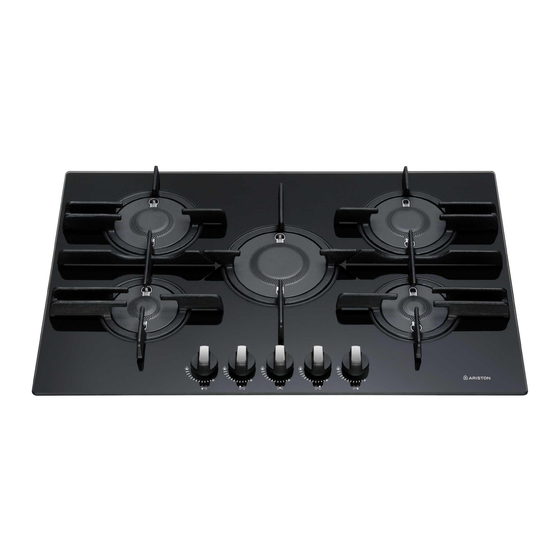Ariston PKQ 755D GH LPG 사용 설명서 - 페이지 14
{카테고리_이름} Ariston PKQ 755D GH LPG에 대한 사용 설명서을 온라인으로 검색하거나 PDF를 다운로드하세요. Ariston PKQ 755D GH LPG 45 페이지.

• The openings used for ventilation and dispersion of heat
GB
must never be covered.
• Always make sure the knobs are in the "●"/"○" position
when the appliance is not in use.
• When unplugging the appliance always pull the plug from
the mains socket, do not pull on the cable.
• Never carry out any cleaning or maintenance work
without having detached the plug from the mains.
• In case of malfunction, under no circumstances should
you attempt to repair the appliance yourself. Repairs
carried out by inexperienced persons may cause injury
or further malfunctioning of the appliance. Contact a
Service Centre (see Assistance).
• Always make sure that pan handles are turned towards
the centre of the hob in order to avoid accidental burns.
• Do not use unstable or deformed pans.
• The appliance should not be operated by people
(including children) with reduced physical, sensory or
mental capacities, by inexperienced individuals or by
anyone who is not familiar with the product. These
individuals should, at the very least, be supervised by
someone who assumes responsibility for their safety or
receive preliminary instructions relating to the operation
of the appliance.
• Do not let children play with the appliance.
• The appliance is not intended to be operated by
means of an external timer or separate remote-
control system.
Disposal
• When disposing of packaging material: observe local
legislation so that the packaging may be reused.
• The European Directive 2012/19/EC on Waste Electrical
and Electronic Equipment )WEEE(, requires that old
household electrical appliances must not be disposed
of in the normal unsorted municipal waste stream. Old
appliances must be collected separately in order to
optimise the recovery and recycling of the materials they
contain and reduce the impact on human health and the
environment. The crossed out "wheeled bin" symbol on
the product reminds you of your obligation, that when you
dispose of the appliance it must be separately collected.
Consumers may take their old appliance to public waste
collection areas, other communal collection areas, or
if national legislation allows return it to a retailer when
purchasing a similar new product.
All major household appliance manufacturers are active
in the creation of systems to manage the collection and
disposal of old appliances.
14
Maintenance and care
Switching the appliance off
Disconnect your appliance from the electricity supply before
carrying out any work on it.
Cleaning the appliance
! Do not use abrasive or corrosive detergents such as stain
removers, anti-rust products, powder detergents or sponges with
abrasive surfaces: these may scratch the surface beyond repair.
! Never use steam cleaners or pressure cleaners on the
appliance.
• It is usually enough to wash the hob with a damp sponge
and dry it with absorbent kitchen roll.
• The removable parts of the burners should be washed
frequently with warm water and soap and any burnt-on
substances removed.
The burner caps should NOT be put in the dishwasher
to prevent dulling of the aluminum part.
• For hobs which ligth automatically, the terminal part of
the electronic instant lighting devices should be cleaned
frequently and the gas outlet holes should be checked
for blockages.
• Before using the hob, the surface must be cleaned, using
a damp cloth to remove dust or food residues. The hob
surface should be cleaned regularly with a soultion of
warm water and a non-abrasive detergent.
• Stainless steel can be marked by hard water that has
been left on the surface for a long time, or by aggressive
detergents containing phosphorus. After cleaning, rinse
and dry any remaining drops of water.
! Do not use stainless steel flame spreaders, bread
toasters or meat grills over gas flames.
